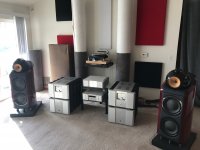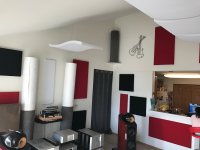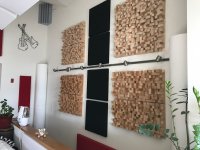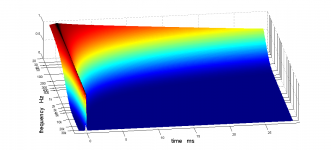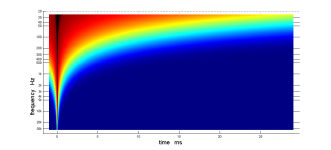Yes, meaning closer placement of speakers to the back wall is preferable as it's easier to treat that wall. That's what he said and I repeated. If you can move the speakers away from the front wall and still sit (meaning you in your listening spot) in front of the center of the room it wouldn't be as big of a problem, but that does not say: leave the front reflective, does it? It would place you closer to your back wall and thus closer to another reflective area. At least that's what your pictures show.
You don't want to be closer to the back wall if you don't have to be, I am, sadly enough, and therefore I have damping there.
I personally aimed for the first 20 ms to be as reflection free as I could get it without being asked to leave the house by a lawyer.
Your case, as I see it, is a very small room, with lots of reflective surfaces. If you want it to sound bigger than it is, lots of work needs to be done to achieve that. Measurements will be able to tell. Without those your guess is as good as mine.
I will stop replying if you keep trying to hammer your point in without supplying any evidence. For instance, what would you call that (TV) thingy between the speakers? I would call it a heavily diffractive unit. That's the first thing I noticed in these pictures and why I emphasized the second part of the quote I posted from Geddes.
How do you sit in front of the center of the room and have your listening position 19% away from the back wall. That doesn't add up to what Jens said. He did say "still sit in front of the center of the room" by that he didn't mean the speakers. You'd want to keep away from that back wall or have no reflection coming from that side at all.
Most designs shift the energy to the back of the room, bounced more than once and re-use that energy. We, in small rooms, have no other option than to absorb if we want a shot at a bigger sounding space.
You don't want to be closer to the back wall if you don't have to be, I am, sadly enough, and therefore I have damping there.
I personally aimed for the first 20 ms to be as reflection free as I could get it without being asked to leave the house by a lawyer.
Your case, as I see it, is a very small room, with lots of reflective surfaces. If you want it to sound bigger than it is, lots of work needs to be done to achieve that. Measurements will be able to tell. Without those your guess is as good as mine.
I will stop replying if you keep trying to hammer your point in without supplying any evidence. For instance, what would you call that (TV) thingy between the speakers? I would call it a heavily diffractive unit. That's the first thing I noticed in these pictures and why I emphasized the second part of the quote I posted from Geddes.
How do you sit in front of the center of the room and have your listening position 19% away from the back wall. That doesn't add up to what Jens said. He did say "still sit in front of the center of the room" by that he didn't mean the speakers. You'd want to keep away from that back wall or have no reflection coming from that side at all.
Most designs shift the energy to the back of the room, bounced more than once and re-use that energy. We, in small rooms, have no other option than to absorb if we want a shot at a bigger sounding space.
Last edited:
Yes, meaning closer placement of speakers to the back wall is preferable as it's easier to treat that wall. That's what he said and I repeated.
no, your speakers close to the front wall is a compromise. the optimal solution is to be 1.5 to 2m away and also still be able to have the LP far from the back wall.
My room is very bad acoustically (its not a symetric room, the left wall is longer then the right which creates bad peaks and dips under the modal region as soon as my speakers or LP is close to the door), and the only good measuring listening position was sadly 19% away from the back wall. 38% didnt measure well at all.
read this huge 14 pages thread talking about SBIR problems: https://www.gearslutz.com/board/studio-building-acoustics/584207-sbir.html
but that does not say: leave the front reflective, does it?
not sure what is your point honestly. I did only talk about MY room. in my room, since im 1.5m away from the front wall, I dont need to treat the front wall at all. are you really disagreeing with this?
if your speaker must be close to the front wall, theres many who says its very hard to limits the SBIR problems, but its probably best to indeed treat the front wall in that situation. read the SBIR thread, this issue is talked about in length and two school of thoughts exist about that. very interesting thread!!!
there's hundreds of thread about how to treat the front wall and it absolutely depends on how close your speakers are to the front wall: https://www.google.ca/search?q=trea...e+front+wall+gearslutz+site:www.gearslutz.com
I personally aimed for the first 20 ms to be as reflection free as I could get it without being asked to leave the house by a lawyer.
🙂
yes, WAF is a limiting factor, not in my case happily. how many db down within 20ms do you aim? it doesnt mean anything to say the "first 20ms". How many DB within the first 20ms is what matters....
For instance, what would you call that (TV) thingy between the speakers? I would call it a heavily diffractive unit.
my tv is in line with the back of my speakers. therefore, all reflections coming from the tv will be secondary reflections. the tv could only be reflective for low frequency since they are omnidirectional, but i dont see how a thin tv would reflect low frequencies, its simply not massive enough. FWIW, in a blind test, I cannot tell when the tv is there or not, so its not a issue. I really did test my friends in a blind test and nobody could say when or not the tv was there. but even theorically, if the tv is behind the front of the speakers, the only reflection coming from the tv would be under the modal region anyways....
How do you sit in front of the center of the room and have your listening position 19% away from the back wall
Jens doesnt mean to sit literally in the middle of the room, this is the worst place. he means 38% away from the front wall. normally its recommend to have the listening position 38% away from the front wall, hence the recommendation to have the speaker very close to the front wall.
https://www.gearslutz.com/board/so-much-gear-so-little-time/163019-38-rule.html
https://www.gearslutz.com/board/studio-building-acoustics/556427-how-important-38-rule.html
also, the 38% listening position rule is not a rule but a starting point. in my room, it didnt measure well. the next option was 38% away from the back wall and again didnt work. I could only get good FR measurements with 19% away from the back wall. its a compromise and I treated behind the bed. the corner traps also act as treatment behind the bed.
Most designs shift the energy to the back of the room, bounced more than once and re-use that energy. We, in small rooms, have no other option than to absorb if we want a shot at a bigger sounding space.
agreed
no, your speakers close to the front wall is a compromise. the optimal solution is to be 1.5 to 2m away and also still be able to have the LP far from the back wall.
My room is very bad acoustically (its not a symetric room, the left wall is longer then the right which creates bad peaks and dips under the modal region as soon as my speakers or LP is close to the door), and the only good measuring listening position was sadly 19% away from the back wall. 38% didnt measure well at all.
read this huge 14 pages thread talking about SBIR problems: https://www.gearslutz.com/board/studio-building-acoustics/584207-sbir.html
but that does not say: leave the front reflective, does it?
not sure what is your point honestly. I did only talk about MY room. in my room, since im 1.5m away from the front wall, I dont need to treat the front wall at all. are you really disagreeing with this?
if your speaker must be close to the front wall, theres many who says its very hard to limits the SBIR problems, but its probably best to indeed treat the front wall in that situation. read the SBIR thread, this issue is talked about in length and two school of thoughts exist about that. very interesting thread!!!
there's hundreds of thread about how to treat the front wall and it absolutely depends on how close your speakers are to the front wall: https://www.google.ca/search?q=trea...e+front+wall+gearslutz+site:www.gearslutz.com
I personally aimed for the first 20 ms to be as reflection free as I could get it without being asked to leave the house by a lawyer.
🙂
yes, WAF is a limiting factor, not in my case happily. how many db down within 20ms do you aim? it doesnt mean anything to say the "first 20ms". How many DB within the first 20ms is what matters....
For instance, what would you call that (TV) thingy between the speakers? I would call it a heavily diffractive unit.
my tv is in line with the back of my speakers. therefore, all reflections coming from the tv will be secondary reflections. the tv could only be reflective for low frequency since they are omnidirectional, but i dont see how a thin tv would reflect low frequencies, its simply not massive enough. FWIW, in a blind test, I cannot tell when the tv is there or not, so its not a issue. I really did test my friends in a blind test and nobody could say when or not the tv was there. but even theorically, if the tv is behind the front of the speakers, the only reflection coming from the tv would be under the modal region anyways....
How do you sit in front of the center of the room and have your listening position 19% away from the back wall
Jens doesnt mean to sit literally in the middle of the room, this is the worst place. he means 38% away from the front wall. normally its recommend to have the listening position 38% away from the front wall, hence the recommendation to have the speaker very close to the front wall.
https://www.gearslutz.com/board/so-much-gear-so-little-time/163019-38-rule.html
https://www.gearslutz.com/board/studio-building-acoustics/556427-how-important-38-rule.html
also, the 38% listening position rule is not a rule but a starting point. in my room, it didnt measure well. the next option was 38% away from the back wall and again didnt work. I could only get good FR measurements with 19% away from the back wall. its a compromise and I treated behind the bed. the corner traps also act as treatment behind the bed.
Most designs shift the energy to the back of the room, bounced more than once and re-use that energy. We, in small rooms, have no other option than to absorb if we want a shot at a bigger sounding space.
agreed
Last edited:
Yes, meaning closer placement of speakers to the back wall is preferable as it's easier to treat that wall. That's what he said and I repeated.
being close to the wall is a compromise. the best solution is to be 1.5 to 2m away and also still be able to have the LP far from the back wall.
My room is very hard acoustically (its not a symetric room, the left wall is longer then the right), and the only good measuring listening position was sadly 19% away from the back wall. 38% didnt measure well at all.
read this huge thread talking about SBIR problems: https://www.gearslutz.com/board/studio-building-acoustics/584207-sbir.html
but that does not say: leave the front reflective, does it?
not sure what is your point honestly. I did only talk about MY room. in my room, since im 1.5m away from the front wall, I dont need to treat the front wall at all. what I said only apply when you can place your speaker well away from the front wall. if your speaker must be close to the front wall, theres many who says its very hard to limits the SBIR problems, but its probably best to indeed treat the front wall in that situation. read the SBIR thread, this issue is talked about in lenght and two school of thoughts exist about that.
there's hundreds of thread about how to treat the front wall and it absolutely depends on how close your speakers are to the front wall: https://www.google.ca/search?q=trea...e+front+wall+gearslutz+site:www.gearslutz.com
I personally aimed for the first 20 ms to be as reflection free as I could get it without being asked to leave the house by a lawyer.
🙂
yes, WAF is a limiting factor, not in my case happily. how many db down within 20ms do you aim? it doesnt mean anything to say the "first 20ms". -10db within the first 20ms is a excellent goal!
For instance, what would you call that (TV) thingy between the speakers? I would call it a heavily diffractive unit.
my tv is in line with the back of my speakers. therefore, all reflections coming from the tv will be secondary reflections. the tv could only be reflective for low frequency since they are omnidirectional, but i dont see how a thin tv would reflect low frequencies, its simply not massive enough. FWIW, in a blind test, I cannot tell when the tv is there or not, so its not a issue. I really did test my friends in a blind test and nobody could say when or not the tv was there. but even theorically, if the tv is behind the front of the speakers, the only reflection coming from the tv would be under the modal region anyways....
How do you sit in front of the center of the room and have your listening position 19% away from the back wall
Jens doesnt mean to sit literally in the middle of the room, this is the worst place. he means 38% away from the front wall. im surprised I have to say this. normally its recommend to have the listening position 38% away from the front wall, hence the recommendation to have the speaker very close to the front wall.
https://www.gearslutz.com/board/so-much-gear-so-little-time/163019-38-rule.html
https://www.gearslutz.com/board/studio-building-acoustics/556427-how-important-38-rule.html
also, the 38% listening position rule is not a rule but a starting point. in my room, it didnt measure well. the next option was 38% away from the back wall and again didnt work. I could only get good FR measurements with 19% away from the back wall. its a compromise and I treated behind the bed. the corner traps also act as treatment behind the bed.
Most designs shift the energy to the back of the room, bounced more than once and re-use that energy. We, in small rooms, have no other option than to absorb if we want a shot at a bigger sounding space.
agreed
I better quote you because it keeps changing. Here we go again, last time for me. Do what you like with it, that's probably not much.
Djeez, this feels really good. I'm offering help here in a thread and I get that (personal) Elephant feeling. Have you read (even a part of) my thread? I have given all the answers to your questions and I know you visited my thread in a very similar 'polite' way.
I'm pretty much done with this discussion. I do show you everything, the APL_TDA plot should tell you what you're looking for. Here's another example:

From this page: http://www.diyaudio.com/forums/full-range/242171-making-two-towers-25-driver-full-range-line-array-148.html
My thread is literally filled with this stuff, front to back with numerous measurements and only gradually improving. I did not get there in a day.
Even though this does not tell the whole story, it is a start to show I'm down with reflections, goal is -20 dB in that first 20 ms, at least in this particular graph. The truth is this graph does not show all frequencies that equally, so no, I can't call this reflection free, I call it: down as far as I can get it without getting into trouble. This isn't DSP, this is room treatment + speaker choice and placement.
As said, I loosely follow the LEDE concept from which the RFZ theory originates. Why? Because I like a good listening experience. I'm not mixing, I'm enjoying music. So I add reflections as a Haas kicker, look up the concept, it used to be a big hit, until the studio guys found out it can make songs sound a bit too good. Not that bad in my book for a listening room as it give me a chance to "forget" I'm actually in a small room. It helps hide my real room. And it enhances the listening experience by making it more "3D". There's theory behind that too, it's in my thread. I didn't make it up, but thankfully use it.
So with the added reflections I can control at will in content, SPL level and band pass:

The Haas kicker is coming in from a lateral angle, diffused (as planned) at 20 ms. That's mimicking a bigger room than I have. Does it mess up the image? No, not at all! Not if it's diffused enough. So what does it do? It enhances the music coming from the front, you'd never know there are speakers there. They can't even be seen as they don't point at the listening space, they reflect off of the sides/back of surrounding furniture.
Looking why I cannot call it reflection free? If you look close enough there is still output above 15 dB.
A wavelet looking 10 dB down:

Not a reflection in sight, nor any crossover shapes or resonances.
15 dB down wavelet:

So what do you know, the filtered IR looks like everything is down by 20 dB. Yet there is still some stuff showing up when I show a 15 dB floor in my Wavelet. Even more important, sometimes it's just a little different, could it be that I am in a fully functional living room? Not in a Studio? With an office chair that I'm sitting on right now not always in the exact same spot?
Can you guess where that stuff is in my APL_TDA plot?

I know what it is I'm seeing, that's even more useful.
So why would anyone chase down all those reflections? Because they mess up your step response, no matter how much DSP you throw at it. So if you want a shot at decent output, with or without help from DSP, take care of those first reflections. Don't name it a reflection free zone until you reach levels like jim1961 gets. Reflection 'reduced' would be a good term in a living room. These reflections give away speaker position and room size to our ears. That's the last thing I want. I want to be at the performance.
Look at this impulse, this one actually is with DSP applied:

Still a lot of reflections in there (not good! Early days of measurements)
By no means are you going to fix that with DSP without serious consequences. The minute you get out of the sweet spot only a little after hammering something like that into shape you will get a way different response.
Look at my later impulse:

Does this look the same to anyone? This is with carefully placed damping panels. Weird looking STEP? That's what a downwards curve frequency response looks like when its following minimum phase band pass behaviour.
I don't want to continue here, I'm done with this.
Stefanoo, I'm still game if you want to, I just don't want to continue this particular useless dribble back and forth, with useless questions, all of which could have been answered in a matter of seconds if he wanted because he knows where to find it. If anyone questions DSP, fine. That's every ones own decision. I came here to share some of the things I've learned over a long period. Share it for free, that is what I do. Because I'm willing to bet I can learn from you guys. That's how it works for me. But not with this one. Not willing to show anything and overstepping my boundaries, that's for sure.
I linked the most important steps in the first post of my thread. Apparently I know nothing to be able to help Mr. YouKnowWho (pun intended) but I'm willing to help any other that's a little more courteous in his ways. As said, I'm in it for fun and learning. This hasn't been fun at all. Twisting my sentences because one fails to do anything productive, like read up is no fun to me. I never said anything about where to sit, as it's of no use in our real world. So you have to adapt to the possibilities. That has serious consequences that I don't see in the presented photos. I think I do know what to expect in measurements and it ain't going to be pretty.
Hope it was fun for you youknowyou, it sure wasn't for me. I merely want to do something back to the community that has thought me well. But to learn anything, this still applies:

Towards you, my dear sir, I cannot have an open mind any longer. This is giving me nothing. It sucks the energy out of me trying to break trough to you.
It's impossible if you're out to deny everything. We can't even agree on a simple post by someone else, if I point that out to you, you're even suggesting it was something I said. The horror! 😡 People like this make me second guess the fun of it all. Sorry for that.
By no means do I ask of another to agree with me or my views. It's not about that at all.
This pointless dribble annoys me though. Especially since it happened before: http://www.diyaudio.com/forums/full-range/242171-making-two-towers-25-driver-full-range-line-array-232.html#post4744524
While the answer was right there all this time. What would anyone get out of this. Maybe, just maybe there's something in it for someone.
Last edited:
what is this? I pointed your errors and you react that way?
seriously, in no way how I answered to you warrant your personal insults.
I answered very politely and intelligently what you said. I have brought very relevant points. since you dont have a answer to my points, you rely on personal insults.
and btw, all I said was not my opinion, but very basics acoustic stuff that most every acousticians acknowledge. everythings Ive said I backed with many threads talking about the issue on hand. I actually only posted to help. I thought the thread about SBIR at gearslutz could interest you for example.
ironic you post a zappa quote which is one of favorite musician of all time. very sorry if your so defensive.
seriously, in no way how I answered to you warrant your personal insults.
I answered very politely and intelligently what you said. I have brought very relevant points. since you dont have a answer to my points, you rely on personal insults.
and btw, all I said was not my opinion, but very basics acoustic stuff that most every acousticians acknowledge. everythings Ive said I backed with many threads talking about the issue on hand. I actually only posted to help. I thought the thread about SBIR at gearslutz could interest you for example.
ironic you post a zappa quote which is one of favorite musician of all time. very sorry if your so defensive.
Last edited:
.....Ill try to take measurements and post them in this post later this week!.....
🙂...probably a good move look forward to if we can learn something from it.
I laugh hard though when I read that my cheap jbl lsr32/6332 were preffered by a danish moderator vs the nautilus 802
This Danish moderator seems to be spot on.
The 802 is a very challenged speaker, looking at its mediocre frequency response and dismal dispersion pattern. The JBL speaker has a straight FR and at least it's midrange driver is not oversized.
How the Danes know their speakers!
I laugh hard though when I read that my cheap jbl lsr32/6332 were preffered by a danish moderator vs the nautilus 802
This Danish moderator seems to be spot on.
The 802 is a very challenged speaker, looking at its mediocre frequency response and dismal dispersion pattern. The JBL speaker has a straight FR and at least it's midrange driver is not oversized.
How the Danes know their speakers!
Ok Vacuumphile....you in lack you can buy those speakers for less than $1500 and save a bunch of money!!
Happy listening to you!!!
youknowyou...sorry I missed your post I was looking back again and I totally missed your room.
question: is that your actual listening room? I notice you have bed in there....
question: is that your actual listening room? I notice you have bed in there....
Pictures of my setup, still not completed I am still working on the center product, but it gives an idea of what my room treatment looks like.
This is far from ideal of course, and I hope to make improvements with the help of experienced people here, but I think it is a good start.
Erik still waiting on you to accept the challenge....are you still up buddy? 😱
This is far from ideal of course, and I hope to make improvements with the help of experienced people here, but I think it is a good start.
Erik still waiting on you to accept the challenge....are you still up buddy? 😱
Attachments
Nice room! Nice equipment! Lets roll 😀
Thanks a lot! Like I said far from being perfect whatsoever, I am sure there is room for improvement!!
Did anybody see my friend Erik anymore? I am dying from the curiosity to see his set up and room and measurements.
The whole thing must be mind blowing I am sure!!

Wow what a dream corner there 🙂
ahahah which corner are you referring to?
Well at angle seen from camera in first picture it looks like we look into nice audio gear corner.ahahah which corner are you referring to?
Are we closer to install Matlab Compiler Runtime, APL_TDA demo, run loop test, in REW via impulse response align microphone in middle at listening spot and then sweep APL_TDA demo to learn and discuss outcome for acoustics performance at listening position 🙂.
Well at angle seen from camera in first picture it looks like we look into nice audio gear corner.
Are we closer to install Matlab Compiler Runtime, APL_TDA demo, run loop test, in REW via impulse response align microphone in middle at listening spot and then sweep APL_TDA demo to learn and discuss outcome for acoustics performance at listening position 🙂.
Oh gotcha now!! Thanks a lot!!
I am Installing it tonight as I have been busy with design stuff in these past days so I didn't get a chance.
I am using M-Audio profire 610 along with an older Sony vaio laptop that has mini FireWire port. Laptop runs on win vista! There are no problems with REW..so hopefully no compatibility problems arise with this SW.
I will keep you posted.
Like you said hopefully we can all gain more knowledge on room interaction and acoustic treatment.
Program is installed.
Now what do I need to do? 😕
Oh 1st class work by you but sorry being late here 😛
APL_TDA setup:
1. Up in left corner we can see ProFire 610 interface ID numbers so in dialog named "Set in out ID" as input delete "-1" and write number "1" and as output delete "-1" and write number "3".
2. Now because program run sound via WDM (no support for exclusive WASAPI or ASIO) then to get setup bit perfect with no sample rate mismatch (distortion), make sure settings both in ProFire 610 control panel and in Windows sound control panel is set to 24bit/96kHz or 16bit/96kHz (check and adjust both I and O sections).
3. If you have right cable it would be nice now to run a test loop just to confirm APL_TDA communicate flawless over interface but its up to you. Connect cable between ProFire 610 Left line I/O and push the big green button "RUN MEASUREMENT". Result should look ala below for "TDA 3D" and "TDA pl" display buttons.
If everything goes well next step is into REW with microphone at listening position to align (get overlayed) L and R speakers IR (impulse response) but think rather like wesayso to either join or take over here but local clock in our zone clock is 06:00AM so not sure his available until later in day : )
Attachments
Last edited:
thank you byrtt!
Unfortunately the different time zone makes this operation a bit more difficult as it adds extra delay.
I will check what cabling I need for loop test (you want me to feed output to input and see that I read correctly?
How do I get impulse response lined up? Is there a reference that describes how to do so?
Thanks.
Unfortunately the different time zone makes this operation a bit more difficult as it adds extra delay.
I will check what cabling I need for loop test (you want me to feed output to input and see that I read correctly?
How do I get impulse response lined up? Is there a reference that describes how to do so?
Thanks.
Hi Stefanoo,
Yes that looptest would be good quality check so we know that later on when sweeping your audio system plot will present the true acoustic performance, and should something weird show up in plot for that loop test then start first look if Profire 610 has any modern DSP enhancement features turned on that needs be disabled. Will look into details for impulse lineup L/R speaker and get back.
Yes that looptest would be good quality check so we know that later on when sweeping your audio system plot will present the true acoustic performance, and should something weird show up in plot for that loop test then start first look if Profire 610 has any modern DSP enhancement features turned on that needs be disabled. Will look into details for impulse lineup L/R speaker and get back.
- Home
- Loudspeakers
- Multi-Way
- B&W Signature 800 upgrade diamond tweeter
